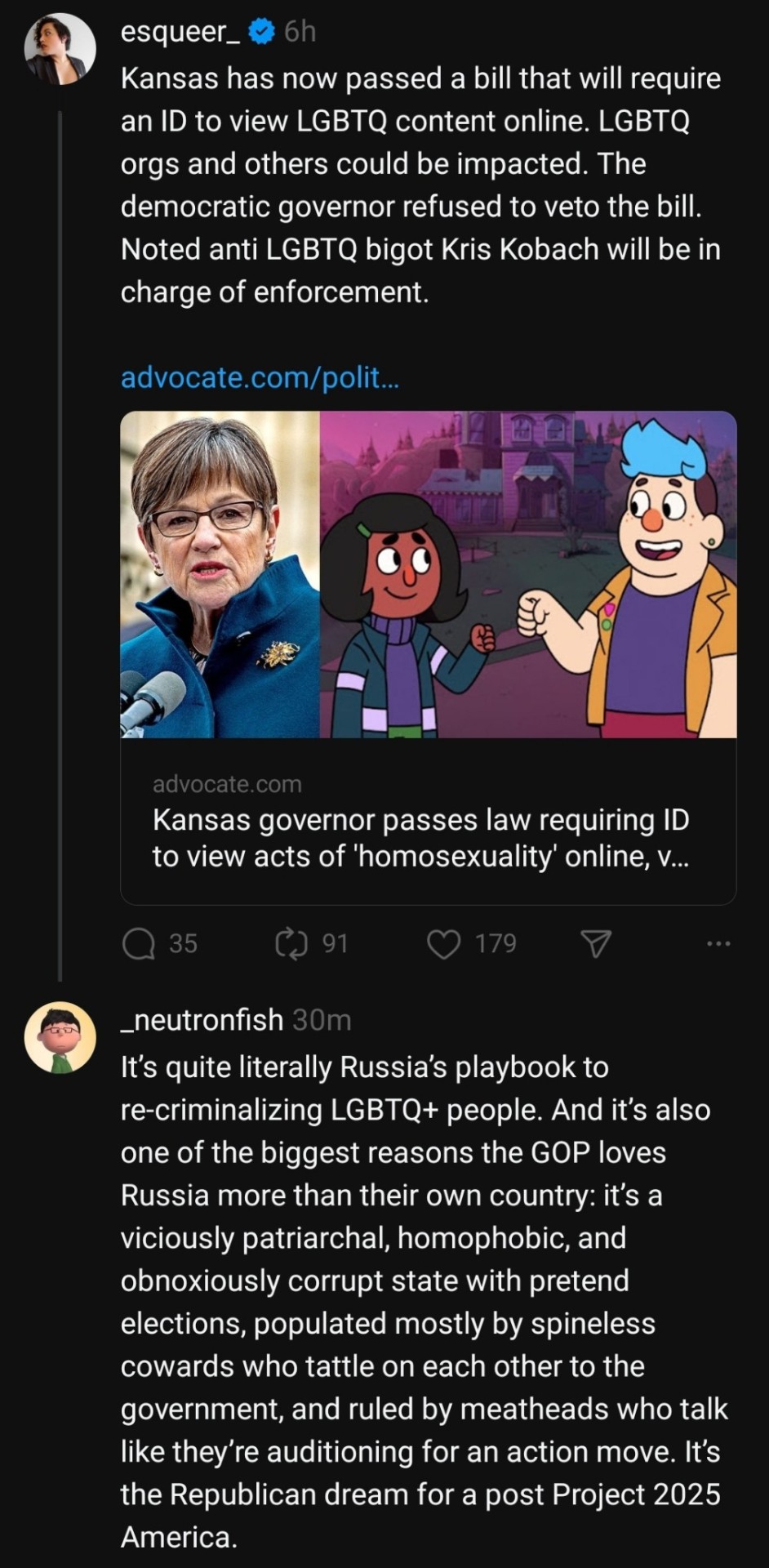Text
(Times) This May Be Our Last Chance to Halt Bird Flu in Humans, and We Are Blowing It

The outbreak of H5N1 avian influenza among U.S. dairy cows, first reported on March 25, has now spread to at least 33 herds in eight states. On Wednesday, genetic evidence of the virus turned up in commercially available milk. Federal authorities say the milk supply is safe, but this latest development raises troubling questions about how widespread the outbreak really is.
So far, there is only one confirmed human case. Rick Bright, an expert on the H5N1 virus who served on President Biden’s coronavirus advisory board, told me this is the crucial moment. “There’s a fine line between one person and 10 people with H5N1,” he said. “By the time we’ve detected 10, it’s probably too late” to contain.
That’s when I told him what I’d heard from Sid Miller, the Texas commissioner for agriculture. He said he strongly suspected that the outbreak dated back to at least February. The commissioner speculated that then as many as 40 percent of the herds in the Texas Panhandle might have been infected.
Dr. Bright fell silent, then asked a very reasonable question: “Doesn’t anyone keep tabs on this?”
The H5N1 outbreak, already a devastating crisis for cattle farmers and their herds, has the potential to turn into an enormous tragedy for the rest of us. But having spent the past two weeks trying to get answers from our nation’s public health authorities, I’m shocked by how little they seem to know about what’s going on and how little of what they do know is being shared in a timely manner.
How exactly is the infection transmitted between herds? The United States Department of Agriculture, the Food and Drug Administration and the Centers for Disease Control and Prevention all say they are working to figure it out.
Sign up for the Opinion Today newsletter Get expert analysis of the news and a guide to the big ideas shaping the world every weekday morning.
According to many public health officials, the virus load in the infected cows’ milk is especially high, raising the possibility that the disease is being spread through milking machines or from aerosolized spray when the milking room floors are power washed. Another possible route is the cows’ feed, owing to the fairly revolting fact that the U.S. allows farmers to feed leftover poultry bedding material — feathers, excrement, spilled seeds — to dairy and beef cattle as a cheap source of additional protein.
Alarmingly, the U.S.D.A. told me that it has evidence that the virus has also spread from dairy farms back to poultry farms “through an unknown route.” Well, one thing that travels back and forth between cattle farms and chicken farms is human beings. They can also travel from cattle farms to pig farms, and pigs are the doomsday animals for human influenza pandemics. Because they are especially susceptible to both avian and human flu, they make for good petri dishes in which avian influenza can become an effective human virus. The damage could be vast.
The U.S.D.A. also told me it doesn’t know how many farmers have tested their cattle and doesn’t know how many of those tests came up positive; whatever testing is being done takes place at the state level or in private labs. Just Wednesday, the agency made it mandatory to report all positive results, a long overdue step that is still — without the negative results alongside them — insufficient to give us a full picture. Also on Wednesday, the U.S.D.A. made testing mandatory for dairy cattle that are being moved from one state to another. It says mandatory testing of other herds wouldn’t be “practical, feasible or necessarily informative” because of “several reasons, ranging from laboratory capacity to testing turnaround times.” The furthest the agency will go is to recommend voluntary testing for cattle that show symptoms of the illness — which not all that are infected do. Dr. Bright compares this to the Trump administration’s approach to Covid-19: If you don’t test, it doesn’t exist.
As for the F.D.A., it tells me it hasn’t completed specific tests to confirm that pasteurization would make milk from infected cows safe, though the agency considers it “very likely” based on extensive testing for other pathogens. (It is not yet clear whether the elements of the H5N1 virus that recently turned up in milk had been fully neutralized.) That testing should have been completed by now. In any case, unpasteurized milk remains legal in many states. Dr. Bright told me that “this is a major concern, especially given recent infections and deaths in cats that have consumed infected milk.”
Making matters worse, the U.S.D.A. failed to share the genomes from infected animals in a timely manner, and then when it shared the genomes did so in an unwieldy format and without any geographic information, causing scientists to tear their hair out in frustration.
All this makes catching potential human cases so urgent. Dr. Bright says that given a situation like this, and the fact that undocumented farmworkers may not have access to health care, the government should be using every sophisticated surveillance technique, including wastewater testing, and reporting the results publicly. That is not happening. The C.D.C. says it is monitoring data from emergency rooms for any signs of an outbreak. By the time enough people are sick enough to be noticed in emergency rooms, it is almost certainly too late to prevent one.
So far, the agency told me, it is aware of only 23 people who have been tested. That tiny number is deeply troubling. (Others may be getting tested through private providers, but if negative, the results do not have to be reported.)
On the ground, people are doing the best they can. Adeline Hambley, a public health officer in Ottawa, Mich., told me of a farm whose herd had tested positive. The farm owner voluntarily handed over the workers’ cellphone numbers, and the workers got texts asking them to report all potential symptoms. Lynn Sutfin, a public information officer in the Michigan Department of Health and Human Services, told me that response rates to those texts and other forms of outreach can be as high as 90 percent. That’s heartening, but it’s too much to expect that a poor farmworker — afraid of stigma, legal troubles and economic loss — will always report even mild symptoms and stay home from work as instructed.
It’s entirely possible that we’ll get lucky with H5N1 and it will never manage to spread among humans. Spillovers from animals to humans are common, yet pandemics are rare because they require a chain of unlucky events to happen one after the other. But pandemics are a numbers game, and a widespread animal outbreak like this raises the risks. When dangerous novel pathogens emerge among humans, there is only a small window of time in which to stop them before they spiral out of control. Neither our animal farming practices nor our public health tools seem up to the task.
There is some good news: David Boucher, at the federal government’s Administration for Strategic Preparedness and Response, told me that this virus strain is a close match for some vaccines that have already been formulated and that America has the capacity to manufacture and potentially distribute many millions of doses, and fairly quickly, if it takes off in humans. That ability is a little like fire insurance — I’m glad it exists, but by the time it comes into play your house has already burned down.
I’m sure the employees of these agencies are working hard, but the message they are sending is, “Trust us — we are on this.” One troubling legacy of the coronavirus pandemic is that there was too much attention on telling the public how to feel — to panic or not panic — rather than sharing facts and inspiring confidence through transparency and competence. And four years later we have an added layer of polarization and distrust to work around.
In April 2020, the Trump administration ousted Dr. Bright from his position as the director of the Biomedical Advanced Research and Development Authority, the agency responsible for fighting emerging pandemics. In a whistle-blower complaint, he alleged this happened after his early warnings against the coronavirus pandemic were ignored and as retaliation for his caution against unproven treatments favored by Donald Trump.
Dr. Bright told me that he would have expected things to be much different during the current administration, but “this is a live fire test,” he said, “and right now we are failing it.”
Zeynep Tufekci (@zeynep) is a professor of sociology and public affairs at Princeton University, the author of “Twitter and Tear Gas: The Power and Fragility of Networked Protest” and a New York Times Opinion columnist. @zeynep • Facebook
A version of this article appears in print on April 28, 2024, Section SR, Page 9 of the New York edition with the headline: The U.S. Is Blowing Its Chance to Halt Bird Flu in Humans. Order Reprints | Today’s Paper | Subscribe
3 notes
·
View notes
Text
Conversations with rovers.
1 note
·
View note
Text
Fox “News” hires the dumbest talking heads they can find.
0 notes
Video
At this hearing, I stand before my fellow members of The Tortured Poets Department with a summary of my findings.
Album tonight.
Fortnight music video tomorrow at 8pm et.
https://taylor.lnk.to/thetorturedpoetsdepartment
10K notes
·
View notes
Text
Gee, empty-headed Republicans with short attention spans? That's kind of a template now. IMHO, the last good Repubican was Eisenhower. The party has failed to make the transition to modernity though, and I fear all we'll be getting from now on are the likes of Trumps and George W. Bushs.

"It hurt to lose to Ronald Reagan. But after the election, I tried to make the transition as smooth as possible. Later, from my experience in trying to brief him on matters of supreme importance, I was very disturbed at his lack of interest. The issues were the 15 or 20 most important subjects that I as President could possibly pass on to him. His only reaction of substance was to express admiration for the political circumstances in South Korea that let President Park close all the colleges and draft all the demonstrators. That was the only issue on which he came alive."
-- Former President Jimmy Carter, on losing the 1980 election and the transition leading to the inauguration of Ronald Reagan, interview with TIME Magazine, October 11, 1982.
6K notes
·
View notes
Text
(LATimes) Michael Hiltzik: The revival of network neutrality - Los Angeles Times

Federal Communications Commission Chair Jessica Rosenworcel shepherded a restoration of network neutrality at the FCC.
(Jonathan Newton / Pool)
In the midst of its battle to extinguish the Mendocino Complex wildfire in 2018, the Santa Clara County Fire Department discovered that its internet connection provider, Verizon, had throttled their data flow virtually down to zero, cutting off communications for firefighters in the field. One firefighter died in the blaze and four were injured.
Verizon refused to restore service until the fire department signed up for a new account that more than doubled its bill.
That episode has long been Exhibit A in favor of restoring the Federal Communications Commission’s authority to regulate broadband internet service, which the FCC abdicated in 2017, during the Trump administration.
This is an industry that requires a lot of scrutiny.
— Craig Aaron, Free Press, on the internet service industry
Now that era is over. On Thursday, the FCC — now operating with a Democratic majority — reclaimed its regulatory oversight of broadband via an order that passed on party lines, 3-2.
The commission’s action could scarcely be more timely.
“Four years ago,” FCC Chair Jessica Rosenworcel observed Thursday as the commission prepared to vote, “the pandemic changed life as we know it. ... Much of work, school and healthcare migrated to the internet. ... It became clear that no matter who you are or where you live, you need broadband to have a fair shot at digital age success. It went from ‘nice to have’ to ‘need to have.’ ”
Yet the commission in 2017 had thrown away its own ability to supervise this essential service. By categorizing broadband services as “information services,” it relinquished its right to address consumer complaints about crummy service, or even collect data on outages. It couldn’t prevent big internet service providers such as Comcast from favoring their own content or websites over competitors by degrading the rivals’ signals when they reached their subscribers’ homes.
“We fixed that today,” Rosenworcel said.
The issue the FCC addressed Thursday is most often viewed in the context of “network neutrality.” This core principle of the open internet means simply that internet service providers can’t discriminate among content providers trying to reach your home or business online — they can’t block websites or services, or degrade their signal, slow their traffic or, conversely, provide a better traffic lane for some rather than others.
The principle is important because their control of the information highways and byways gives ISPs tremendous power, especially if they control the last mile of access to end users, as do cable operators such as Comcast and telecommunications firms such as Verizon. If they use that power to favor their own content or content providers that pay them for a fast lane, it’s consumers who suffer.
Net neutrality has been a partisan football for more than two decades, or ever since high-speed broadband connections began to supplant dial-up modems.
In legal terms, the battle has been over the classification of broadband under the Communications Act of 1934 — as Title I “information services” or Title II “telecommunications.” The FCC has no jurisdiction over Title I services, but great authority over those classified by Title II as common carriers.
The key inflection point came in 2002, when a GOP-majority FCC under George W. Bush classified cable internet services as Title I. In effect, the commission stripped itself of its authority to regulate the nascent industry. (Then-FCC Chair Michael Powell subsequently became the chief Washington lobbyist for the cable industry, big surprise.)
Not until 2015 was the error rectified, at the urging of President Obama. Broadband was reclassified under Title II; then-FCC Chair Tom Wheeler was explicit about using the restored authority to enforce network neutrality.
But that regulatory regime lasted only until 2017, when a reconstituted FCC, chaired by a former Verizon executive Ajit Pai, reclassified broadband again as Title I in deference to President Trump’s deregulatory campaign. The big ISPs would have geared up to take advantage of the new regime, had not California and other states stepped into the void by enacting their own net neutrality laws.
A federal appeals court upheld California’s law, the most far-reaching of the state statutes, in 2022. And although the FCC’s action could theoretically preempt the state law, “what the FCC is doing is perfectly in line with what California did,” says Craig Aaron, co-CEO of the consumer advocacy organization Free Press.
The key distinction, Aaron told me, is that the FCC’s initiative goes well beyond the issue of net neutrality — it establishes a single federal standard for broadband and reclaims its authority over the technology more generally, in ways that “safeguard national security, advance public safety, protect consumers and facilitate broadband deployment,” in the commission’s own words.
Although Verizon’s actions in the 2018 wildfire case did not violate the net neutrality principle, for instance, the FCC’s restored regulatory authority might have enabled it to set forth rules governing the provision of services when public safety is at stake that might have prevented Verizon from throttling the Santa Clara Fire Department’s connection in the first place.
Until Thursday, the state laws functioned as bulwarks against net neutrality abuses by ISPs. “California helped discourage companies from trying things,” Aaron says. Indeed, provisions of the California law are explicit enough that state regulators haven’t had to bring a single enforcement case. “It’s been mostly prophylactic,” he says — “telling the industry what it can and can’t do. But it’s important to have set down the rules of the road.”
None of this means that the partisan battle over broadband regulation is over. Both Republican FCC commissioners voted against the initiative Thursday. A recrudescence of Trumpism after the November election could bring a deregulation-minded GOP majority back into power at the FCC.
Indeed, in a lengthy dissenting statement, Brendan Carr, one of the commission’s Republican members, repeated all the conventional conservative arguments presented to justify the repeal of network neutrality in 2017. Carr painted the 2015 restoration of net neutrality as a liberal plot — “a matter of civic religion for activists on the left.”
He asserted that the FCC was then goaded into action by President Obama, who was outspoken on the need for reclassification and browbeat Wheeler into going along. Leftists, he said, “demand that the FCC go full-Title II whenever a Democrat is president.”
Carr also depicted network neutrality as a drag on profits and innovation in the broadband sector. “Broadband investment slowed down after the FCC imposed Title II in 2015,” he said, “and it picked up again after we restored Title 1 in 2017.”
Carr chose his time frame very carefully. Examine the longer period in which net neutrality has been debated at the FCC, and one finds that broadband investment crashed after a Republican-led FCC reclassified broadband as an information service in 2002, falling to $57 billion in 2003 from $111.5 billion in 2001.
Investment did decline between 2015, when net neutrality rules were reinstated, and 2017, when they were rescinded — by a minuscule 0.8%. It hasn’t been especially robust since then — as of 2002 it was still running at only about 92% of what it had been two decades earlier.
As the FCC observed in Thursday’s order, “regulation is but one of several factors that drive investment and innovation in the telecommunications and digital media markets.”
The commission cited consumer demand and the arrival of new technologies, among others. Strong, consistent regulation, moreover, opens the path for new competitors with new ideas and innovations — and can bring prices down for users in the process.
The truth is that network neutrality has been heavily favored by the public, in part because examples of ISPs abusing their power were not hard to find. In 2007, Comcast was caught degrading traffic from the file-sharing service BitTorrent, which held contracts to distribute licensed content from Hollywood studios and other sources in direct competition with Comcast’s pay-TV business.
In 2010, Santa Monica-based Tennis Channel complained to the FCC that Comcast kept it isolated on a little-watched sports tier while giving much better placement to the Golf Channel and Versus, two channels that compete with it for advertising, and which Comcast happened to own. The FCC sided with the Tennis Channel but was overruled by federal court.
Even barring a change at the White House, the need for vigilant enforcement will never go away; ISPs will always be looking for business models and manipulative practices that could challenge the FCC’s oversight capabilities, especially as cable and telecommunications companies consolidate into bigger and richer enterprises and combine content providers with their internet delivery services.
“This is an industry,” Aaron says, “that requires a lot of scrutiny.”
#long post#refrigerator magnet#michael hiltzik#net neutrality#internet#utility#fcc#better than four years ago#politics#republicans#internet is a utility
1 note
·
View note
Text
Will the corrupt SCOTUS with seats stolen by Mitch McConnell allow Trump to get away with all this again? The man is never held accountable for anything.
#politics#republicans#maga me sick#maga#trump#fake electors#the big lie#insurrection#2020 election#trump on trial#will he get away with it again?
0 notes
Text
Earth Day painting

🌱An Earth Goddess for Earth Day 🌱
Art prints
4K notes
·
View notes
Text
The late Daniel Dennett on "belief."
1 note
·
View note
Text
Murrieta Valley board defies California, will keep policy to tell parents about LGBTQ+ transitioning
-Even in California???-
By Howard BlumeStaff Writer

People at a Murrieta Valley school board meeting in August cheer after the board voted 3 to 2 to approve a parent-notification policy on student gender identification.
(Gina Ferazzi / Los Angeles Times)
The Murrieta Valley Board of Education has defied a state order — and countermanded its own staff — by reaffirming a policy that requires parents to be notified when students change their gender identity on campus, putting the district at the center of a raging culture-war battle over how best to protect the interests of both students and parents.
The board voted 3 to 2 on Thursday night to keep its parent-notification policy, which requires administrators, teachers and counselors to notify parents or guardians in writing within three days after any district employee has learned that a student is requesting to be “identified or treated as a gender other than the student’s biological sex or gender listed on the student’s birth certificate or any other official records.”
An investigation by the California Department of Education concluded that the notification rules were discriminatory and therefore illegal. Its April 10 report ordered the Riverside County school system of 22,000 students to rescind the policy. The school board’s defiant reaction signals that conservative local officials are willing to challenge the state’s interpretation of the law as well as the state’s overall authority to intervene in local matters of this sort.
“We have a right as a board to defy a dictatorial governor and bureaucracy — or whatever — that tries to take away our rights as parents and as citizens — as a duly elected board,” said board member Nick Pardue. “We have legal standing and we should absolutely stand up for our rights against dictators.”
The Department of Education had no immediate response Friday.
A clear majority of more than 100 parents, community members and activists who packed the board room applauded. They cheered again when board President Paul Diffley, without comment, hesitated, then broke a 2-2 tie.
In a later interview, Diffley said he hesitated only because he was recalling public comments at an earlier meeting from a young adult who’d had gender reassignment surgery and then regretted it.
“A parent has the right till a child is 18 to know everything that is critical,” he added.
The vast majority of speakers supported the parent-notification policy, including Wes Schaeffer, a local father of seven who held his first baby grandchild as he challenged the idea that teachers should be tasked with keeping a secret.
“I think maybe the government is overstepping its boundaries,” he added.
Speakers against the policy included the board’s student member, Isabella Dadalt.
Cheers from the audience over the announcement of Dadalt’s acceptance to UCLA became uncomfortable silence and murmurs as Dadalt began a long list of her reasons for opposing the policy.
“I do not believe that their students would ever withhold information from their parents unless they were genuinely forced to,” she said. “So if you’re a parent, and you feel threatened by the fact that your student is going to a teacher instead of you, I think you need to rethink your parenting.”
Parent-notification policies that target gender identity have spread to a relatively small number of the state’s 1,000 school systems — most commonly in inland, rural or strongly conservative enclaves.
Supporters believe parents have a fundamental right to be involved in all aspects of their children’s lives, especially on matters as consequential as gender identification. And they assert that state and federal law gives local school boards the latitude they need to approve such policies — and parents the right to demand them.
Opponents say parental-notification policies are being used to violate student privacy and civil rights enshrined in state law and the education code — and that the near-universal outing of transgender students to parents would put some children at serious risk. They say that transgender and other nonconforming students are being singled out as convenient targets for political gain.
This issue is playing out in litigation up and down California.
In this instance, on April 10, the state Department of Education ordered the Murrieta district, within five days, to provide written notice to all employees and students that the notification policy is “inconsistent” with state education code and will “not be implemented.”
Two days later, in an effort to follow those instructions, the district administration sent out an unsigned notice, from the “Murrieta Valley USD Administrative Team,” that appears to comply with the state directive.
In deference to the state order, district administrators had placed on Thursday’s agenda an action to rescind the parent-notification policy entirely, while leaving open the door to revisit the issue later.
By that point, however, the board majority had run out of patience with its own staff as well as the state — especially after listening to a procession of parents expressing outrage that the policy, approved in August, had yet to go into effect. They had learned of the delay only when the district sent out its notice about ending the policy.
Board member Julie Vandegrift proposed an amendment that affirmed the policy and called for it to take effect as soon as possible. And that was the version that passed.
Board members Linda Lunn and Nancy Young voted no.
In a later interview, Lunn said the effort to create and defend a divisive policy — in a district that already carefully protects the interests of parents and students — continues to consume district time and resources.
“This is weaponizing Murrieta Valley Unified to play politics with Sacramento, and they’re using taxpayer money to do it,” Lunn said.
“I believe in following the law and the Education Code,” Young said. “They don’t all seem to understand that [the Education] Code is the law.”
The state investigation was prompted when two teachers filed a complaint. While the state has kept their identities confidential, both have come forward publicly. One of the instructors, Karen Poznanski, who teaches sixth- and seventh-graders at Dorothy McElhinney Middle School, is also a district parent with a child who is nonbinary.
“This policy, whether enforced or not, hindered our LGBTQ+ students from living authentically,” Poznanski said in an email. “Moreover, it not only compromised their privacy and dignity, but also perpetuated harm and discrimination against LGBTQ+ individuals and their families. ... This is discrimination and an abuse of power in its most blatant form.”
Board member Pardue, a history teacher in another school system, cited state and constitutional provisions as supporting the board’s action.
State Atty. General Rob Bonta strongly disagrees and has sued Chino Valley Unified, one of several districts that approved a version of parent notification that shared a common template. The matter is the subject of several ongoing lawsuits.
Pardue noted a preliminary ruling has allowed the policy to remain in force in nearby Temecula Valley Unified School District.
A different judge reached a different conclusion with Chino Valley Unified, with a preliminary ruling that the parent-notification policy was discriminatory and, therefore, illegal. The analysis by the California Department of Education, or CDE, as laid out in its report to the Murrieta district, aligns closely with that of the judge in the Chino Valley case.
“The CDE finds the District’s policy ... on its face singles out and is directed exclusively toward one group of students based on that group’s legally protected characteristics of identifying with or expressing a gender other than that identified at birth,” the state letter says. “And the application of that policy adversely impacts those students.” Moreover, the Murrieta policy “does not expressly or implicitly provide any educational or school administrative purpose justifying ... discrimination.”
The report says that districts that fail to comply can face a court order and could ultimately lose funding.
The Chino Valley school system recently revised its policy in hopes that it will survive legal challenges while still accomplishing the original intent.
Chino Valley school board President Sonja Shaw said parents in Murrieta and Chino Valley have expressed frustration over the state’s position and urged her to press on.
“We will continue to stand strong, linked arms all over California, to ensure the government does not infringe on parental rights — period,” Shaw said.
For those opposing the policy, the success of the teachers’ complaint with state officials could suggest a roadmap for elsewhere, said Amanda Mangaser Savage, who is representing teachers and parents trying to overturn the Temecula policy they define as forced outing.
“What we’re likely to see,” Mangaser Savage said, “is other educators submitting CDE complaints, which CDE would then handle similarly.”
Hey, school systems: Don't let a trans kid's family be their first bully!
0 notes
Photo
Tortured Swifties Department?




The Tortured Poets Department. An anthology of new works that reflect events, opinions and sentiments from a fleeting and fatalistic moment in time - one that was both sensational and sorrowful in equal measure. This period of the author’s life is now over, the chapter closed and boarded up. There is nothing to avenge, no scores to settle once wounds have healed. And upon further reflection, a good number of them turned out to be self-inflicted. This writer is of the firm belief that our tears become holy in the form of ink on a page. Once we have spoken our saddest story, we can be free of it.
And then all that’s left behind is the tortured poetry.
THE TORTURED POETS DEPARTMENT is out now.
https://taylor.lnk.to/thetorturedpoetsdepartment
12K notes
·
View notes
Photo

Eclipse, ink and gelly rolls on 27x36cm paper.
6K notes
·
View notes
Photo
Taylor

The first single from The Tortured Poets Department is…………. Fortnight featuring @postmalone 🤍 I’ve been such a huge fan of Post because of the writer he is, his musical experimentation and those melodies he creates that just stick in your head forever. I got to witness that magic come to life firsthand when we worked together on Fortnight. Honestly can’t wait for you guys to hear this song at Midnight TONIGHT and see the video at 8pm ET TOMORROW.
forafortnight.com
10K notes
·
View notes
Text

Doze-O The Clown nods off at his trial.
#doze-o the clown#politics#maga me sick#trump#hush money#stormy daniels#adultery#cheeto#unfaithful#liar#election
0 notes
Text
How is this legal? And what qualifies as homosexual acts? Going to brunch? Watching “Drag Race?”

The homophobia is used to deflect.
Million on the Right, millions in churches, and millions of homophobes are projecting their criminal lives onto the LGBTQ community.
713 notes
·
View notes
